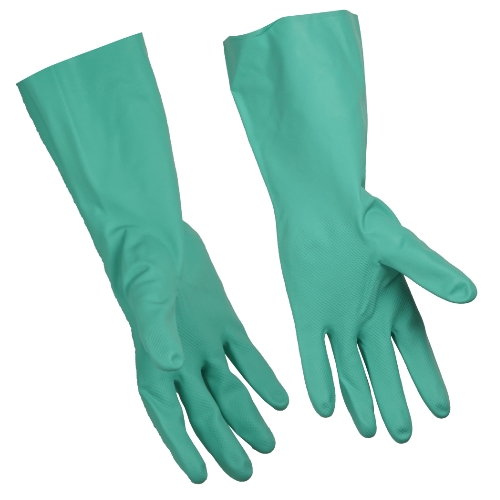




Quick Links:





Gloves must be worn whenever significant potential hazards from chemicals, cuts, lacerations, abrasions, punctures, burns, biologicals, or harmful temperature extremes are present. The proper use of hand protection can help protect from potential chemical and physical hazards. Gloves must be worn when using chemicals that are corrosive or easily absorbed through the skin.
There is not one type of glove that offers the best protection against all chemicals or one glove that totally resists degradation and permeation to all chemicals. All gloves must be replaced periodically, depending on the type and concentration of the chemical, performance characteristics of the gloves, conditions and duration of use, hazards present, and the length of time a chemical has been in contact with the glove.
All glove materials are eventually permeated by chemicals; however, they can be used safely for limited time periods if specific use and other characteristics (i.e., thickness, permeation rate, and time) are known.
Glove manufacturers publish glove selection charts for their products. These should be consulted to determine the resistance to chemicals of common glove materials and determining the specific type of glove material that should be worn for use with a particular chemical.
Before working with any chemical, always read manufacturer instructions and warnings on chemical container labels and SDSs. Recommended glove types are sometimes listed in the PPE section in SDSs. If the recommended glove type is not listed on the SDS, then laboratory personnel should consult with the manufacturersʼ glove selection charts. These charts typically include commonly used chemicals that have been tested for the manufacturersʼ different glove types. Different manufacturers use different formulations so check the glove chart of the specific manufacturer for the glove you plan to use
If the manufacturersʼ glove chart does not list the specific chemical you will be using, then contact the manufacturer directly and work with their technical representatives to determine which glove is best suited for your particular application.

Some general guidelines for glove use include:
Wear appropriate gloves when the potential for contact with hazardous materials exists. Laboratory personnel should inspect gloves for holes, cracks, or contamination before each use. Any gloves found to be questionable should be discarded immediately.
Disposable gloves must not be re-used.
Reusable gloves should be replaced periodically, depending on the frequency of use and permeability to the substance(s) handled. Reusable gloves should be rinsed with soap and water between uses. Discard disposable gloves after each use and whenever they become contaminated.
Due to potential chemical contamination, which may not always be visible, gloves must be removed before leaving the laboratory. Do not wear gloves while performing common tasks such as answering the phone, grabbing a door handle, using an elevator, etc. If gloves are needed to transport anything, wear one glove to handle the transported item – using a secondary container such as a bucket. The free, ungloved hand is then used to touch door knobs, elevator buttons, etc. If you are wearing gloves to “protect your sample from you” and are in the hall, no one else understands this and will be concerned about the items you have contaminated with those gloves.
A common practice to use with disposable gloves is “double-gloving”. This is accomplished when two pairs of gloves are worn over each other to provide a double layer of protection. If the outer glove becomes contaminated, starts to degrade, or tears open, the inner glove continues to offer protection until the gloves are removed and replaced.
The best practice is to check outer gloves frequently, watching for signs of degradation (change of color, change of texture, tears, etc.). At the first sign of degradation or contamination, always remove and dispose of the contaminated disposable gloves immediately and double-glove with a new set of gloves. If the inner glove appears to have any contamination or degradation; remove both pairs of gloves, and double glove with a new pair.
When working with mixtures of chemicals, it may be advisable to double glove with two sets of gloves made from different materials. This method can offer protection in case the outer glove material becomes permeated by one chemical in the mixture, while allowing for enough protection until both gloves can be removed. The type of glove materials selected for this type of application will be based on the specific chemicals used as part of the mixture. Check chemical manufacturers glove selection charts first before choosing which type of glove to use.
To properly remove disposable gloves, grab the cuff of the left glove with the gloved right hand and remove the left glove. While holding the removed left glove in the palm of the gloved right hand, insert a finger under the cuff of the right glove and gently invert the right glove over the glove in the palm of your hand and dispose of them properly. Be sure to wash your hands thoroughly with soap and water after the gloves have been removed.


Consider the following factors when choosing gloves:

Chemically-resistant gloves come in a wide variety of materials. The recommendations given below for the specific glove materials are based on incidental contact. Once the chemical makes contact with the gloved hand, the gloves should be removed and replaced as soon as practical. Often a glove specified for incidental contact is not suitable for extended contact, such as when the gloved hand can become covered or immersed within the chemical in use. Before selecting chemical resistant gloves; consult the glove manufacturers’ recommendations or their glove selection charts, or contact HSE at hse@kaust.edu.safor more assistance.
Resistant to ketones, alcohols, caustics, and organic acids. See note below.
Resistant to mineral acids, organic acids, caustics, alcohols, and petroleum solvents.
Resistant to alcohols, caustics, organic acids, and some ketones.
Rated for chemicals considered highly toxic and chemicals that can be easily absorbed through the skin. These gloves are chemically resistant to a wide range of materials that readily attack other glove materials. These gloves are not recommended for use with Chloroform. Common brand names include: Silver Shield by North Hand Protection, 4H by Safety4, or New Barrier by Ansell Edmont.
Resistant to mineral acids, caustics, organic acids, and alcohols.
Resistant to chlorinated solvents, petroleum solvents, and aromatics.
The use of latex gloves, especially thin, disposable exam gloves, for chemical handling should be avoided because latex offers little protection from commonly used chemicals. Latex gloves can degrade severely in minutes or seconds. Latex gloves can cause an allergic reaction in a percentage of the population due to several proteins found in latex.
Symptoms can include nasal, eye, or sinus irritation, hives, shortness of breath, coughing, wheezing, or unexplained shock. If any of these symptoms become apparent in personnel wearing latex gloves, discontinue using the gloves and seek medical attention immediately.
Due to possible health concerns associated with latex allergy, the use of pre-powdered disposable latex gloves is not permitted. Only under the following conditions shall the use of non-powdered latex gloves be permitted.

